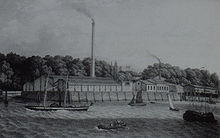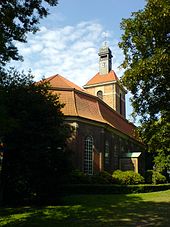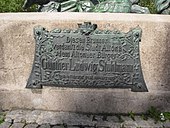Günther Ludwig Stuhlmann
Günther Ludwig Stuhlmann (born February 10, 1797 in Neumühlen , † March 30, 1872 in Nice ) was a German entrepreneur and patron. The Stuhlmann fountain in Altona is named after Günther Ludwig Stuhlmann .
origin
Günther Ludwig Stuhlmann was a son of Chamber Councilor Casper Hinrich Stuhlmann and his wife Sophia Dorothea, née Detenhof. He was baptized on March 19, 1797 in the Christian church in Ottensen . Besides their son Günther Ludwig, the couple probably only had one other child, their daughter Dorothea Henriette.
The Stuhlmann family owned a lime distillery in Neumühlen on the Elbe beach, which Casper Hinrich Stuhlmann had set up in 1794 on the site of a former iron factory. It was located at Grosse Elbstrasse 151. Stuhlmann's family had owned the factory for a short time in 1759, but then sold it again. The property had the advantage that factories of all kinds could be built here and operated with fire. This privilege, which came from King Friedrich IV, did not exist on any other property between Altona and Blankenese.
The gas company
Günther Ludwig Stuhlmann did not spend his life exclusively in this place. He lived temporarily in Hamburg and in Wandsbek. In 1840 and 1841, according to the records of the Johannisloge "To the three roses", he was on the road. Stuhlmann evidently trained himself to be a gas and water supply specialist. For several years he ran a gas company that was used to illuminate the casino in Copenhagen and was built by him. His travels also took him to England, France and Belgium. In 1853, together with JS Lowe, he planned to found a company that had the goal of supplying Altona and the surrounding area with gas and purified Elbe water, and wanted to use his father's lime kiln property for this purpose. The contract was signed on August 9, 1854. It soon became apparent, however, that the property was on the one hand too small, on the other hand it was too close to the sluice influences of Hamburg and Altona to draw water from the Elbe there. Following the recommendation of the engineer William Lindley , only the gas station was built on Stuhlmannschen Land, while the waterworks in Blankenese was built. The gas works went into operation in 1857 and the waterworks in 1859. Stuhlmann received 6,000 marks courant annually for the use of the property. This created a capital from which his foundations could later emerge.
The Masonic chair man
Günther Ludwig Stuhlmann was a Freemason and donated legates to the boxes "Carl zum Felsen" and "Zu den drei Rosen". When Christian VIII died, efforts arose to move the "Carl zum Felsen" lodge from the Danish Grand Lodge to the Grand State Lodge of Germany. Stuhlmann was sent from Copenhagen to Germany as an intermediary. However, it was unsuccessful, especially since the lodge brothers in Altona still remembered that he had played a prank on them a long time ago that cost him a lot of popularity. Presumably he resigned from the "Carl zum Felsen" lodge in 1851. But despite these differences, Stuhlmann left the “Carl zum Felsen” lodge in 2000, Mark Courant, with whom the Stuhlmann Fund was founded. 250 Marks Courant flowed into the existing Petersen fund of the lodge “To the three roses”. Both funds had charitable purposes. Stuhlmann also supported the Masonic Hospital in Hamburg, founded in 1795.
Death and legacy

Stuhlmann died in Nice. His body was transferred to Altona and buried on April 14, 1872 in the new churchyard near the thief pond. The monumental tomb has not survived, but the grave inscription on a replacement tombstone from 1956: Günther Ludwig Stuhlmann. His legacies remain testimony to the love for home.
These legacies have left their mark on Altona: Stuhlmann made his will in 1869, stating that, among other things, a public garden should be laid out in Altona with his money. Although he later revoked this clause, the green area that still exists today was laid out on the corner of Billrothstrasse and Hospitalstrasse in Altona in 1883. 6000 marks from Stuhlmann's fortune were used for this.
Another request by Stuhlmann was the construction of a morgue in Altona. The building was built at the municipal hospital in Weidenstrasse (today: Karl-Wolff-Strasse). In addition, Stuhlmann gave the Christian church in Ottensen a legacy of 10,000 Marks Courant, which was intended for a new church tower. The money was not enough for this purpose, but a new tower was built in 1898, which the architect Albert Petersen had planned.
As the last point of the will, the construction of a fountain in Altona was tackled with a tender in 1897. The Berlin sculptor Paul Türpe won the competition with a design called “Kampf”. The dispute between two centaurs was later interpreted as a representation of the competition between Hamburg and Altona for fishing rights. The Stuhlmann Fountain was put into operation in 1900, but could not be erected in the place desired by Stuhlmann because there was now a victory column there. Also, the fountain was not made of iron, as Stuhlmann had imagined, decorated with the Altona city arms and illuminated at night.
In 1938 the interest income from Stuhlmann's property had become so low that it could no longer finance the operation of the Stuhlmann fountain. The remaining assets were transferred to the assets of the city of Hamburg, which from then on had to take care of the maintenance of the well. In 1939 the “Stuhlmann Foundations” file was closed.
Honors
At the Diebsteich cemetery in Hamburg-Altona there is an honorary grave for Günther Ludwig Stuhlmann.
literature
- Kathrin Offen-Klöckner, Günther Ludwig Stuhlmann - A citizen of Altona donates a fountain and uses it to erect a water-spouting monument , in: Ottensen district archive, Stiftung Denkmalpflege Hamburg (ed.), Der Stuhlmannbrunnen. Symbol and landmark in the heart of Altona , Hamburg 2000, ISBN 3-933374-72-3 , pp. 25–33
Web links
- Biography and Stuhlmann's grave of honor at Förderkreis Ohlsdorfer Friedhof
| personal data | |
|---|---|
| SURNAME | Stuhlmann, Günther Ludwig |
| BRIEF DESCRIPTION | German entrepreneur and patron |
| DATE OF BIRTH | February 10, 1797 |
| PLACE OF BIRTH | Neumühlen |
| DATE OF DEATH | March 30, 1872 |
| Place of death | Nice |




